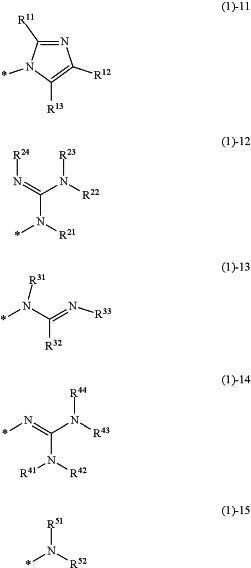| CPC C08K 5/3435 (2013.01) [C07D 295/192 (2013.01); C07D 307/88 (2013.01); C08F 20/32 (2013.01)] | 20 Claims |
|
1. A photoreactive composition, comprising:
a base-reactive compound;
a photobase generator that is represented by the following Formula (1) and that generates a base when irradiated with light; and
at least one compound selected from the group consisting of a polycyclic aromatic compound having a fused ring structure having two or more rings, and a polycyclic aromatic compound having three or more aromatic rings and having a conjugated structure including any two or more of the three or more aromatic rings,
wherein the base-reactive compound is a compound having two or more groups that will have their polarity converted by the action of a base and that exhibit reactivity, in one molecule, or a compound having two or more groups that will react under the action of a base, in one molecule:
 wherein, in Formula (1), G is a divalent aromatic group; and X is a group represented by the following Formula (1)-11, (1)-12, (1)-13, (1)-14, or (1)-15; and
 wherein, in Formula (1)-11 to Formula (1)-15, each of R11, R12, R13, R22, R23, R24, R32, R33, R41, R42, R43, and R44 independently represents a hydrogen atom or a hydrocarbon group; each of R21, R31, R51, and R52 independently represents a hydrocarbon group; in a case in which two or more of R11, R12, and R13 are hydrocarbon groups, these hydrocarbon groups are optionally bound to each other to form a ring; in a case in which two or more of R21, R22, R23, and R24 are hydrocarbon groups, these hydrocarbon groups are optionally bound to each other to form a ring; in a case in which two or more of R31, R32, and R33 are hydrocarbon groups, these hydrocarbon groups are optionally bound to each other to form a ring; in a case in which two or more of R41, R42, R43, and R44 are hydrocarbon groups, these hydrocarbon groups are optionally bound to each other to form a ring; R51 and R52 are optionally bound to each other to form a ring; and a bond marked with a symbol * is formed toward a carbon atom to which X is bound.
|